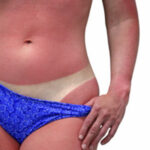There are three degrees of skin burns For example, first-degree burns are mild burns and affect just the top layer of the skin. Symptoms of this type of burn are redness, pain, and minor swelling. This type of burn can be due to sunburns or mild scalding of the skin. These burns usually heal within five or six days and does not leave a permanent scar.
Second-degree burns, also known as partial-thickness burns, affect both the top layer of the skin and the second layer. These burns, besides being painful, usually form blisters, fluid discharge, and mottled skin. The pain in second degree burns is much more painful than first-degree burns. According to the book, “A Practical Guide to Everyday Health Decisions,” if this type of burn covers an area larger than a square inch, get medical care because partial-thickness burns can be fatal if more than 50 percent of the body is involved. In this type of burn, healing takes three to four weeks and may leave scars.
Third-degree burns destroy all skin layers and may penetrate deep below the surface of the skin. The damaged skin may be red, white, or charred black. Because there is a lot of nerve damage, there may be no pain and little bleeding. If you or someone you know, have these symptoms, and if you suspect third degree burn, a doctor should be seen immediately. Skin grafts will be necessary. Scars may occur, depending upon the severity of the burn.
In order to relieve the pain in any type of burns, apply cold, wet compresses, do not use ice unless that is the only type of cold available. The wet compresses stops the burning feeling below the skin surface by dissipating the heat that remains after the initial burn.
For minor burns, it is suggested in “A Practical Guide to Everyday Health Decisions” to use bacitracin after soaking the burned area in cold water. This technique will prevent dehydration. Following this procedure, apply a light gauze bandage and tape where skin is not burned.
For chemical burns that have affected the eye, before calling the doctor, quickly remove the chemical from the eye by flushing the eye with a constant stream of cool,clean water for at least 20 minutes. This will reduce the risk of permanent eye damage. Do not bandage the eye before seeing the doctor.
If a burn is caused by electricity, this is considered to be serious, and medical help is important. Although this type of burn may not seem threatening, it can be deep and there could possibly be extensive internal damage. Electricity can also cause the heart to stop beating or to beat unevenly. It is important to remember never to touch a person of an electrical injury until you are certain the power is turned off. “A Practical Guide to Everyday Health Decision” reminds the readers that an electric current can be turned off by flipping the main breaker or removing the fuse.
Source: A Practical Guide to Everyday Health Decisions







